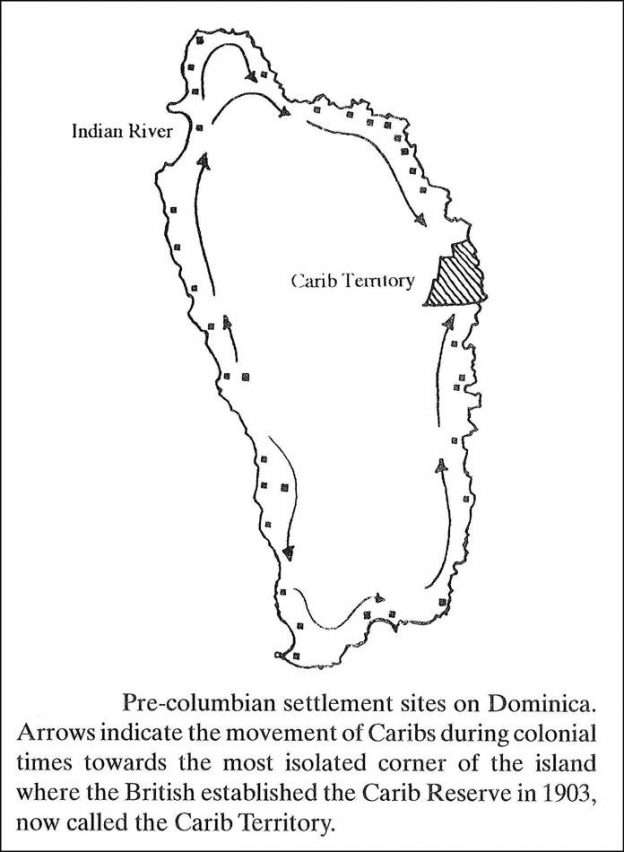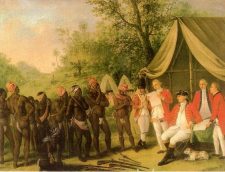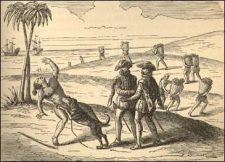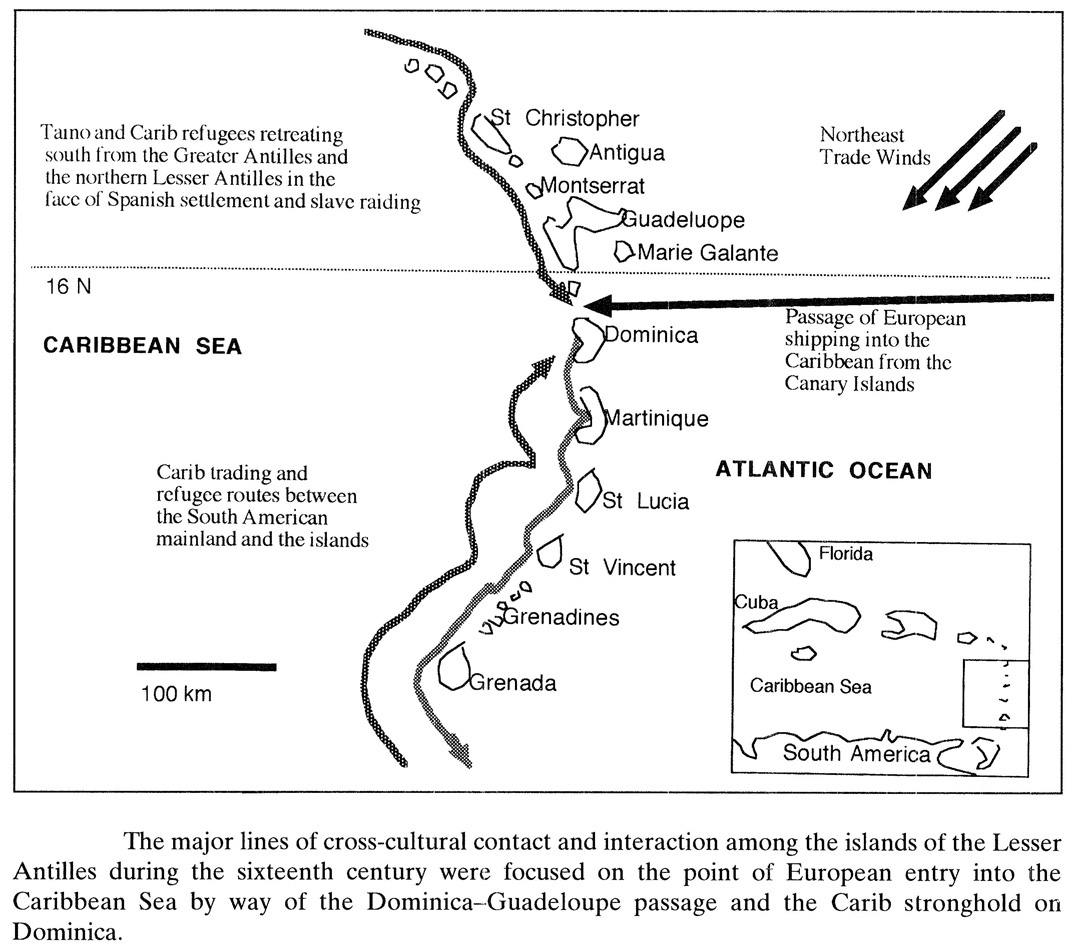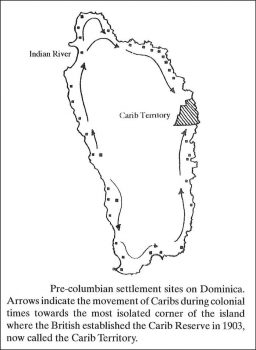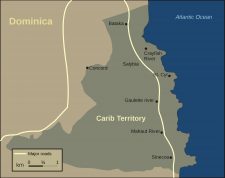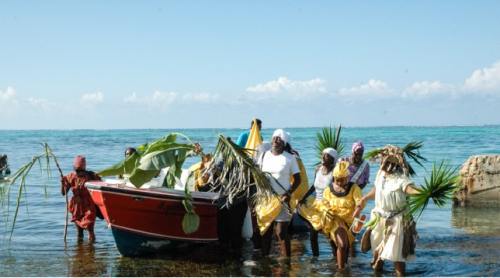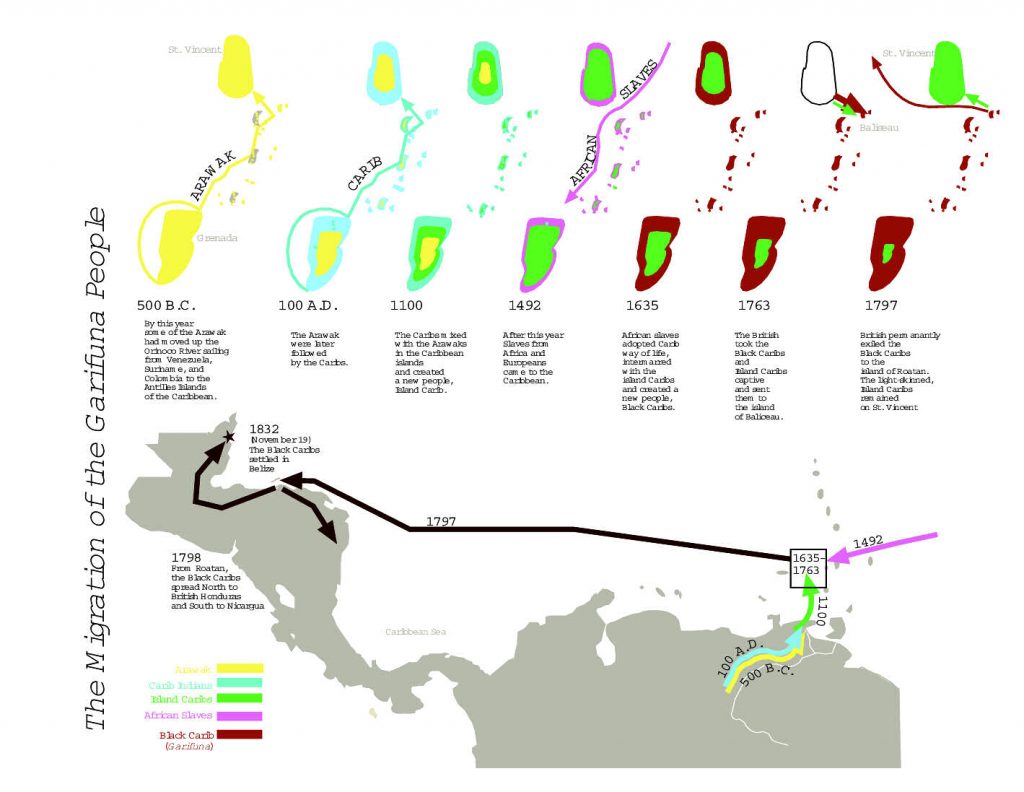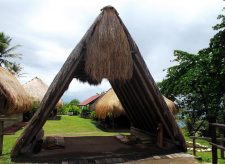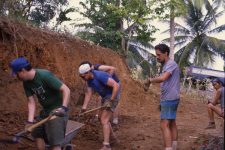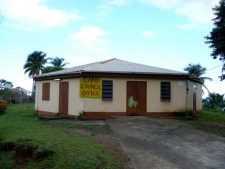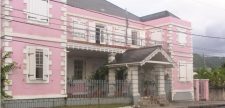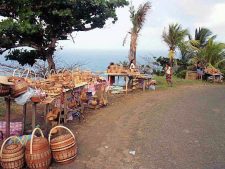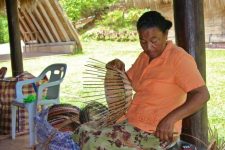[yasr_visitor_votes size=”medium”]
History of the Arawak and Carib tribes.
When the Europeans arrived the indigenous people of the Caribbean were Arawak Taíno.
These Taino Arawaks were native Amerindians, originating from the Orinoco delta.
Compared to other tribes the Taino were a relatively peacefull Arawak population.
At the time of European they were the principal inhabitants in the Caribbean region.
They spoke the Taíno language, one of several Arawakan languages.
Before that the island of Saint Vincent in the eastern Caribbean was inhabited by the Arawak Amerindians.
Their existence drastically changed when two slaveships stranded on the cliffs.
The combined cultures resulted in the Black Caribs.
The Garifuna or Black Caribs.
The British colonial administration used the term Black Carib and Garifuna, to distinguish them from Yellow and Red Carib
The word “Garifuna”, which means “cassava eating people”, is probably descended from “Kalipuna”.
The Spanish called these people “Caribes” (Caribs) which means cannibals, the word from which “Caribbean” is descended.
Evolution from Taino to Kalipuna and finally to Garifuna.
Kalinago is another word for Island Caribs.
- St. Vincent was first inhabited by a peacefull tribe of Indians, Taino Arawaks.
- Then a more aggressive Kalipuna tribe from mainland South America invaded St. Vincent.
They subsequently conquered the Arawaks. - The Arawak men were all killed and the Kalipuna warriors took the Arawak women as wives.
From then onwards the inhabitants of the island were the union of Kalipuna and Arawaks.
From now on they are called Kalinago or Island Caribs.
The Spanish genocide from 1492 to 1518.
During the Taino genocide the Spanish wiped out most of the Tainos (Arawaks).
This started the end of existence for native people in the northern Caribbean.
Resistance was suppressed by demonizing the Kalinago.
The Kalinago resisted the Spanish rather than succumbing like the more peaceful Arawak speaking Tainos who preceded them.
For this reason they were demonized in much the same way as the “voodoo savages” of Haiti would later be demonized.
It was considered a punishment for daring to overthrow their slave masters and threaten the whole system of Caribbean plantocracy.
Trading of the Caribs with the Europeans.
The weakening of their hold on Dominica began from the time that the first Spanish caravelles dropped anchors in Prince Rupert’s Bay, shortly after the second voyage of Columbus.
From then on, ships of all nations came regularly to collect wood and water and to trade with the Caribs for fruit and cassava flour.
The Caribs under the Spanish in Trujillo.
The Spanish rounded up 1,700 Caribs on the island and brought them to Trujillo where laborers were much needed.
The Spanish were not good farmers and Trujillo suffered accordingly.
On the other hand, the Caribs were very skillful at farming so they went to work and did very well in Trujillo.
Some of the Caribs were conscripted into the Spanish army where they served with distinction.
1635 Shipwreck of 2 slaveships on Dominica.
Garifuna is the name for descendants of Nigerian slaves and Caribs.
In 1635 two Spanish slave ships shipwrecked on Saint Vincent.
The Nigerian slaves mixed with the Amerindian population, resulting in Black Caribs.
At first, the Spanish, Nigerians and Kalipuna fought one another but eventually learned to get along and intermarried, thus creating the Black Caribs.
At that time St. Vincent was a British colony and the Caribs tried to establish independent control of the island.
The French supported the Caribs and there were many battles between the Caribs and the British.
The greatest battle took place in 1795 and both sides suffered great losses.
In 1796 the Caribs and the French surrendered to the British.
The British now had a problem.
The Caribs were free men with black skin and St. Vincent was populated by slave-owning Europeans.
- The idea of a group of free black men living among them on the island was unacceptable, so the British decided to deport the Caribs.
The British hunted down and rounded up the Caribs, killing hundreds in the process and destroying their homes and culture.
The remaining 4,300 Caribs were shipped to Balliceaux where half of them died of yellow fever.
1651 – The last 30 Caribs in Grenada leap to their death.
The Spanish managed to account for most of the Tainos in the Greater Antilles.
The Caribs put up fierce resistance against the Spanish and subsequently the French and English throughout the Lesser Antilles, which had been their undisputed territory from about 1400.
In 1651 the last 30 Caribs in Grenada leapt to their death at Sauteurs cliff, rather than surrender to the French.
A Carib lament records the demise of this proud people:
Tooking ma kanari Minara tanara manaricou Kimabouisi cana kivacou.
Destroyed our strength; myself without birthright, food or weapon.
Without strength my plants, our land and water.
Without weapons I am destroyed.
Our strength is without defences, fortress or land.
Relations between the French and Carib population.
By 1700 French lumbermen had established their ateliers along the leeward coast of Cominica and soon the Caribs were withdrawing to the windward side.
The Black Caribs exchanged land rights for rum, brass bowls, iron axes, cutlasses and hoes.
Dominica as French colony: 1715–1763
Wai’tukubuli (Dominica) with its inaccessible mountains and forests is a natural citadel, it became the last Carib stronghold and retreat.
Abase for attacking neighbouring colonies and the site of reprisal massacres.
Although declared neutral territory by the French and English in 1686 and again in 1748, French settlers had established themselves on the west coast by 1700.
Subsequently the Caribs began withdrawing to the wild east coast.
British colony Dominica: 1763–1978.
- As part of the 1763 Treaty of Paris that ended the Seven Years’ War, the island became a British possession.
The British established a legislative assembly, representing only the white population. - In 1865, after much agitation and tension, the colonial office replaced the elective assembly with one composed of one-half elected members and one-half appointed.
Dominica was transferred from the Leeward Island Administration and was governed as part of the Windwards until 1958 when Dominica joined the new West Indies Federation. - In 1961 an independent Dominican Labor Party government was elected.
Dominica became an associated state of the United Kingdom on February 27, 1967 - On November 3, 1978, the Commonwealth of Dominica was granted independence by the United Kingdom.
When the British formally took over in 1763 European conquest was complete.
British surveyors divided the island up into lots for sale and plantations were established around the island.
This was done, legend has it, at the request of Queen Charlotte, wife of George III.
This subsequently developed into the myth that Charlotte had left them half of Dominica.
This is a myth which today many older Caribs consider, erroneously, to be an historical fact.
The last Carib stronghold.
For another 130 years the Caribs were left to themselves.
Shadowy figures hardly seen by the growing Creole society of African slaves, free men and European officials and landowners.
Now and then they appeared in the estate yards and at Sundays markets.
Mainly to sell baskets and fish, but quickly dissolved into the mountains once more along forest tracks towards Salybia.
In 1797 the surviving Caribs were shipped to Roatan Island off the coast of Honduras.
Along the way, the Spanish captured one of the British ships which was taken to Trujillo where the captured Caribs did well.
Later, the Spanish captured Roatan Island from the British.
Deportation of Black Caribs to Honduras and Belize.
It wasn’t until 1797 that the Black Caribs of St Vincent (descendants of Caribs and runaway slaves) were finally defeated by the British.
They were dumped on the islands off Honduras and Belize.
Arrival of the Black Caribs in Belize.
They were put ashore in the area near Stann Creek and what is now Punta Gorda.
At the time, Belize was held by the British and was called British Honduras.
The Caribs continued to serve the Spanish army with distinction, earning medals of valor. At one point, the fortress at San Felipe was commanded by a Carib.
Gradually more Caribs moved to the Stann Creek area in British Honduras.
The Caribs on Dominica pledge for help to the Queen.
Robert Hamilton was sent by the British Colonial Office as Commissioner in 1893 to find out why Dominica was more backward.
The british had noticed that Dominica was less developed than almost any other of the islands.
Hamilton wondered why its people were less prosperous and contented than her Majesty’s other West Indian subjects.
Them he received a tragic letter from the Caribs:
In the name of God, my Lord,
We humble beg of your kindness to accept our petition of your poor people, Indians or Caraibe, of Salibia, to implore the mercy of our Beloved Mother and Queen Victoria, for her poor and unfortunate children.We don’t have nothing to support us, no church, no school, no shop, no store. We are very far in the forest; no money, no dress.
They call us wild savages.No my beloved Queen, it is not savages but poverty.
We humble kneel down in your feet to beg of your assistance.
Accept your humble children of Salibia.
Nine years afterwards an enlightened Administrator, Heskeith Bell, sent a lengthy report to the Colonial Office.
In this letter making certain proposals for the future of the Caribs.
He advised that 3,700 acres should be set aside for them and that a chief should be officially recognised by the colony and given a token allowance of six pounds annually. This was approved, and a year later the chief was invested with a silver headed staff and ceremonial sash.
Economically and socially, however there was no improvement and emotions flared up in September 1930 in a conflict with police over smuggling.
Dominica as a refuge for Caribs.
For almost two centuries, contact was limited to trading and occasional skirmishes.
By the mid seventeenth century Dominica had become a refuge for Caribs retreating from the other islands.
There the surge of French, English and Dutch colonisation was sweeping from off their ancestral lands.
The rugged mountains of Dominica, thick forest and iron coastline provided a natural citadel for the final retreat.
From this base they made attacks on the fledgling European colonies and suffered at least two massacres in retaliation.
Lack of British involvement on Dominica.
By the time a British Commission in 1893 arrived to investigate Conditions, the Caribs had been reduced to living on 232 acres at Salybia.
Their petition to the Commissioner makes pitiful reading:
We don¹t have nothing to support us, no church, no school, no shop, no store. We are very far in the forest; no money, no dress. They call us wild savages. ..It is not savages but poverty.
The British formally granted some 3,700 acres of common land to the Caribs in 1903.
They officially recognized the office of chief (effectively no more than village elder).
Yet conditions barely improved.
Independence in 1978 and successive governments dominated by Afro Dominican politicians have hardly alleviated conditions for modern Caribs.
Most of whom live by farming or fishing, supplementing their subsistence lifestyle by the traditional crafts of basket work or dugout canoe building.
The harsh economics of small island life and the incursions of the global village have all taken their toll on Carib identity.
Garifuna settlement day.
Because of their alignment with the Spanish, the Caribs found themselves on the wrong side of the political fence when Central America achieved independence from Spain.
Those Caribs in Trujillo found themselves in the new country of Honduras where sentiments against Spain were strong.
It is this migration that is celebrated annually as Garifuna Settlement Day.
This is a major holiday in Garifuna communities celebrated on November 19th.
Spreading of the Caribs along the continent.
Gradually, the Caribs spread up and down the coast of Belize.
During this century, some Caribs served on US and British merchant vessels during World War II and travelled the world.
As a result, there are now small communities of Garifuna in Los Angeles, New Orleans and New York City.
You can enlarge this map which shows the Garifuna diaspora.
View the Carib and Arawak migration map as pdf.
Garifuna culture is a mix between many religions and beliefs.
The Garifuna culture is very strong with great emphasis on music, dance and story-telling.
The religion of Garifuna has its own brand, consisting of a mix of Catholicism, African and Indian beliefs.
- Because of their difference and independence, over the years the Garifuna have been feared and discriminated against by Guatemalans and variously accused of devil-worship, polygamy, voodoo and speaking a secret language.
The government of Guatemala officially recognized the importance of the Garifuna community and President Arzu paid an official visit to the town of Livingston.
The Garifuna culture is a unique treasure.
Caribs on Dominica at present day.
This is the Caribbean’s largest remaining community of Caribs.
In Bataka, Salybia, Sinecou, and other hamlets along the main east coast road, tourists can watch artisans at work and purchase crafts from roadside stands.
Intricately woven grass baskets, hats, and mats are Carib specialties.
This Carib-sanctioned center displays historical photographs and sells traditional Carib arts and crafts.
The Carib territory on Dominica.
The mixed descendants of the last Island Caribs who inhabited the Lesser Antilles live on the north-east coast of Dominica.
This simple fact has been so exaggerated and distorted over the last thirty years of tourism publicity.
As a result there tends to be much misunderstanding, bewilderment and eventual disappointment among visitors who come to view the Carib Territory as one of the ‘attractions’ of Dominica.
Visually there is little to differentiate it from any other part of rural Dominica.
The same small farms of mixed crops dominated by bananas and coconuts are clustered around the roadside and surrounding hills.
Same houses as elsewhere, some made of concrete.
Some other houses made of wood, surrounded by tidy flower gardens face onto the road.
One slight distinction may be that some of the wooden houses are raised on stilts to shelter drying timber, cocoa, coffee or reeds for basket making.
The Ajoupa here below is a traditional shelter and welcoming landmark at the Kalinago Barana Aute
Increasingly you’ll see the family pick-up truck packed nearby and television aerials sprouting from bamboo poles.
Perhaps a thatched outhouse or kitchen utilising traditional materials and building methods may be seen.
Only three things hint the remnants of a disappearing tribe:
- The small craft shops selling the basketwork which follows style and patterns handed down for centuries.
- Now and then the sight of a half finished canoe being hollowed out of the single trunk of a giant Gommier tree.
- The sight of people whose skin tone and facial structure vaguely recall the Mongolian origin of their forefathers, who once had free rein over all these islands.
Massacres of the Caribs by Europeans.
- The massacre at Anse De Mai in 1635.
- Another in 1674 at the village which is still called Massacre today.
Arrival of Missionaries on Dominica.
Christianity was first introduced in 1642.
Missionaries of the Dominican, Capucine and Jesuit Orders installed themselves at various points on the island.
Supposed cannibalism as cause for extermination.
The missionaries had little spiritual success but collected masses of anthropological data on the Carib language and way of life.
At the same time propaganda was being used to justify extermination.
Pamphleteers in Europe were having a field day on the subject of Carib cannibalism.
All outdoing each other to create ever gory accounts about the consumption of human flesh.
Being a Frenchman, his story concludes, of course, that the French were the most tasty!
These stories may have been based on the occasional ceremonial use of ancestor and enemy remains.
Extremely late development of Dominica.
It was only in 1970 that a motorable road was cut through the area and telephones and electricity followed in the 1980’s.
Bananas and coconuts have improved earnings.
But because all the land is owned in common, it is intensively used and therefore has the most serious soil erosion problem in Dominica.
The island has hence suffered deforestation.
The Carib function of council chief.
The position of the Chief is less romantic than most visitors like to believe.
In 1952 a Carib Council was created as part of a local government system for the whole island.
Legislation was upgraded at Independence in 1978 with the Carib Reserve Act.
There are elections every five years and the Chairman of the Council is designated the ‘Chief.
Except for this title, he plays the same role as all the other village Council Chairmen in Dominica.
Chairman of the council and the Parliamentary Representative,
To further confuse the matter the Carib Territory as it is now popular called, also has a Parliamentary Representative.
This representative sits in the House of Assembly in Roseau and is elected every five years.
The Chief and the Parliamentary Representative usually make an effort to relate to each other.
In fact the Representative sitting in the nation’s House of Assembly has more power than the Chief.
However, the Chief is more in demand as the spokesman for the Territory.
He does so particularly by visiting journalists and international conferences on Amerindian and Aboriginal affairs.
Location of the Carib territory.
There are only two difficult landing places on this wild and dramatic shoreline.
One is at Salibia Bay where you can see the rocky Salibisie Islets and the Church of St. Marie with its altar carved in the shape of a canoe.
A walk through the Carib community on Dominica.
Walking straight down the hill opposite the Salybia Police Station you come to the mouth of the Crayfish or Isulukati River where waterfalls cascade from rock pools over a stony ledge into the sea.
The Snake’s Staircase.
A fifteen minute walk from the hamlet of Sineku takes you to L’escalier Tete Chien or the Snake’s Staircase – Tete Chien being the local name for the boa constrictor because its head look like that of a dog.
Geologically, this rock formation is called a dyke.
It resembles a gigantic petrified serpent crawling up the hillside from the ocean with its back crystalised into wedges of rock which forms a natural staircase.
This ‘escalier’ features prominently in Carib myth and folklore.
The rock at Sineku.
Natural landmarks such as the rock at Sineku are highlights of ancient Carib mythology. A huge rock overlooking Pagua River near Atkinson, the islets off Londonderry beach, a cave near Kraibo Bay at Wesley were once featured in Carib tales, most of which have long been forgotten.
Local artwork by the Garifuna.
The strongest link with the past are the Carib baskets which are sold in little craft shops all along the road through the Carib Territory.
The brown, white and black designs of the larouma reed have been handed down from generation to generation.
The square paniers and side bags are made in two layers with heliconia leaves in between.
- This waterproof design is a remnant from the days when food and goods had to be kept dry from sea spray in the open canoes and from rainfall along the forest trails across the mountainous interior.
Such a basket is the most authentic souvenir you can get from the Caribbean and from the people who gave the region its name
Misconceptions of Carib History.
Although the history of Caribbean is slowly being rewritten by the descendants of slaves and indentured labourers from a Creole rather than a colonialist perspective.
Little has been done to correct the European stereotyping of the original inhabitants of these islands.
Thus resulting in a further insult, added to the horrendous genocide they had already suffered.
Many Caribbean school textbooks still perpetuate the myth of Carib cannibalism, for which the experts agree there is little historical evidence.
Human flesh was not eaten as food but as a ritual practice.
To gain possession of dead enemies’ or ancestors’ qualities.
This might occur before a raiding expedition or during initiation when it was hoped young men would inherit the bravery of a distinguished warrior.
The Caribs or Kalinago -Island Caribs – (as the Amerindians who migrated up through the Antilles called themselves Kalinago to distinguish themselves from their parent tribe in north west Guyana).
The work of Jacob Frederick.
It’s in this context that the work of Jacob Frederick and other cultural activists like the recently elected Chief Garnett Joseph must be viewed.
Frederick is a self- taught artist, attempting to document events in Carib history like the 1930 uprising (which his mother then a small child vividly remembers).
Frederick documented many Carib myths, legends and lifestyle.
The 1997 Carib Canoe Project.
It was Garnett Joseph who conceived the historic 1997 Carib Canoe Project.
This voyage of rediscovery involved constructing a 35ft dugout from a single giant gommier tree and sailing down the islands back to the ancestral homelands in Guyana.
This was the original voyage of migration in reverse.
A practical demonstration of boat-building and navigational skills – (“I wanted to see if the boats were worthy of a long sea voyage”).
But in particular the voyage was about re-establishing Carib identity among Dominican Caribs and contacts with the culture which was slipping from them.
It was an opportunity to search out the Caribs in South America, to see if they’d retained parts of the culture we’d lost, so we could learn and bring it back,” Federick said.
- He painted the hull of the Gli Gli canoe using a traditional Taino motif and the canoe proved just as worthy as the 80 footers of 500 years before.
There were emotional reunions with Carib descendants down the islands and a state reception from the Ministry of Amerindian Affairs in Guyana. - But three years later much of the euphoria of the voyage has dissipated.
Frederick has been back to Guyana to learn hammock making from the Macussi and Wapishana tribes of the Rupununi but other planned cultural exchanges have not materialized.
He hoped to set up an art school on the Territory. - For now he’s focusing on “the first visual arts exhibition in the Carib Council Office”. Besides, his own work, two other family members will be exhibiting.
His brother and former Chief Faustulus (who pioneered calabash carving on the Territory) and eldest daughter.
Debbie paints, makes copper jewelry and does calabash carving. - Among his paintings which are intuitively representational is the historical 1930 Uprising, in which the head of Jolly John presides over a depiction of the fatal shooting incident. For Frederick this is also family history as his Uncle Royer was one of the men killed. Another picture commemorates the old trail through the forest and over the mountains Carib farmers took to carry produce down to Roseau market on the west coast, a three to four day trek.
- His most impressive piece to date is a complex wood carving called ‘Legends’ celebrating local tribal myths and legends.
At the base of the carving is the great snake which is said to have emerged from the sea at ‘L’Escalier Tete Chien’ (staircase of the dog-headed boa).
This is the guardian spirit of the Caribs, which can be invoked by burning an offering of tobacco in the forest at Sineku above the petrified rock stairway. - At the head of the staircase in the carving is the wrinkled figure of the sorceress Bihi.
She chased her daughter and the daughter’s lover Ebitimu up into the sky where the three became transfixed as the constellation Orion.
Another legendary figure commemorated is Hiali, father of the Carib nation who was turned into the moon after his mother discovered his incestuous relationship with his sister. - Besides the Gli Gli, a small hawk which is a Carib symbol of bravery,
Frederick has decorated the reverse of the carving, with some of the petroglyphs found at Londonderry Bay, further north. In future work he plans to incorporate many more of these traditional motifs. - While his plans for a Territory art school remain on hold, he has not abandoned his mission of keeping Carib culture alive for future generations and educating the young people of the Territory.
Inspired by artifacts he has recently dug up around Salybia, the oldest settlement, he has founded an archaeological club “to develop interest among the young people in traditional arts.” (Simon Lee – Caribbean Today writer)
Links.
- Caribs –
- Joseph Palacio – How did the Garifuna become indiginous people?
- Yesterday & Today
- Re-enacting History – The GliGli Project
- Carib
- Territory Scapes
- The Bell Report
- of 1902
- Assembly of First Nations
- Canada “Defending Aboriginal Sovereignty”
- Historical Notes on The Territory
- Garifuna Information Source
- Aragorn Studios
- United Confederation Of Taino
- People (UCTP)
Since much of this content can be found in one or another way on many sites, owners of copyright are unknown.
However: if you claim rights on any of this sites content then do not hesitate in contacting us.
